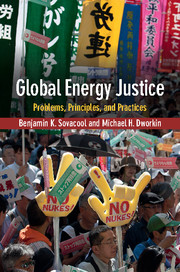Book contents
- Frontmatter
- Epigraph
- Dedication
- Contents
- Analytical table of contents
- List of figures
- List of tables
- Acknowledgements
- List of abbreviations
- 1 Introduction
- 2 The global energy system
- 3 Virtue and energy efficiency
- 4 Utility and energy externalities
- 5 Energy and human rights
- 6 Energy and due process
- 7 Energy poverty, access, and welfare
- 8 Energy subsidies and freedom
- 9 Energy resources and future generations
- 10 Fairness, responsibility, and climate change
- 11 The imperative of making just energy decisions
- Index
- References
4 - Utility and energy externalities
Published online by Cambridge University Press: 05 October 2014
- Frontmatter
- Epigraph
- Dedication
- Contents
- Analytical table of contents
- List of figures
- List of tables
- Acknowledgements
- List of abbreviations
- 1 Introduction
- 2 The global energy system
- 3 Virtue and energy efficiency
- 4 Utility and energy externalities
- 5 Energy and human rights
- 6 Energy and due process
- 7 Energy poverty, access, and welfare
- 8 Energy subsidies and freedom
- 9 Energy resources and future generations
- 10 Fairness, responsibility, and climate change
- 11 The imperative of making just energy decisions
- Index
- References
Summary
In 1945, planners in Orissa, India, faced a dilemma. The upper draining basin of the Mahanadi River passed through Orissa (later renamed the state of Odisha), causing massive floods in some years coupled with devastating droughts in others. Hydrological and engineering assessments concluded that a series of storage reservoirs, dykes, and dams could help regulate this uneven distribution of water. These assessments revealed that the best place to locate the largest of these projects would be 15 kilometers from Sambalpur, where a 5 kilometer long earthen dam could prevent the Mahanadi River from swelling during the monsoon season and regulate the drainage of 83,400 square kilometers of land, providing flood control to the districts of Cuttack and Puri. Such a dam could also help irrigate 75,000 square kilometers of crops throughout the districts of Sambalpur, Bargarh, Bolangir, and Subarnpu, in addition to providing 307.5 MW of hydroelectricity. At the time, in aggregate, these benefits would reach upwards of 3 million people.
However, achieving these benefits would come at the cost of flooding almost 150,000 acres (600 square kilometers) of land that would become a permanent reservoir. It would also require the forced relocation of more than 150,000 people from 22,000 families. In short, building the dam would necessitate “substantial mass agitation.”
- Type
- Chapter
- Information
- Global Energy JusticeProblems, Principles, and Practices, pp. 125 - 156Publisher: Cambridge University PressPrint publication year: 2014



